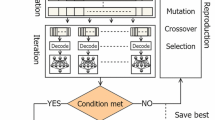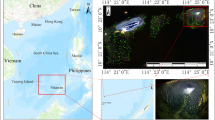Abstract
In this paper, a hybrid intelligent system is developed to estimate sea-ice thickness along the Labrador coast of Canada. The developed intelligent system consists of two main parts. The first part is a heuristic feature selection algorithm used for processing a database to select the most effective features. The second part is a hierarchical selective ensemble randomized neural network (HSE-RNN) that is used to create a nonlinear map between the selected features and sea-ice thickness. The required data for processing have been collected from two sensors, i.e. moderate resolution imaging spectro-radiometer (MODIS), and advanced microwave scanning radiometer-earth (AMSR-E) observing system. To evaluate the computational advantages of the proposed intelligent framework, it is given brightness temperatures data captured at two different frequencies (low frequency, 6.9GHz, and high frequency, 36.5GHz) in addition to both atmospheric and oceanic variables from forecasting models. The obtained results demonstrate the computational power of the developed intelligent algorithm for the estimation of sea-ice thickness along the Labrador coast.










Similar content being viewed by others
References
Aksenov YP, Ekaterina E, Yool A, Nurser AJ, George W, Timothy D, Bertino L, Bergh J (2016) On the future navigability of Arctic sea routes: High-resolution projections of the Arctic Ocean and sea ice. Marine Policy
Aslanargun A, Mammadov M, Yazici B (2007) Comparison of ARIMA, neural networks and hybrid models in time series: tourist arrival forecasting. J Stat Comput Simul 77(1):29–53
Belchansky GI, Douglas DC, Platonov NG (2008) Fluctuating Arctic sea ice thickness changes estimated by an in situ learned and empirically forced neural network model. J Clim 21(4):716–729
Broomhead DS, Lowe D (1988) Multivariable functional interpolation and adaptive networks. Compl Syst 2:321–355
Burger M, Neubauer A (2003) Analysis of Tikhonov regularization for function approximation by neural networks. Neural Netw 16(1):79–90
Caya A, Buehner M, Carrieres T (2010) Analysis and forecasting of sea ice conditions with three-dimensional variational data assimilation and a coupled ice-ocean model. J Atmos Ocean Technol 27(2):353–369
Çelebi M (2009) A new approach for the genetic algorithm. J Stat Comput Simul 79(3):275–297
Chuang L, Hsiao CJ, Yang CH (2011) Chaotic particle swarm optimization for data clustering. Expert Syst Appl 38(12):14555–14563
Côté J, Gravel S, Methot A, Patoine A, Roch M, Staniforth A (1998) The operational CMC-MRB Global Environmental Multiscale (GEM) Model. Part 1: Design considerations and formulation. Mon Wea Rev 126:1373–1395
Draa A, Bouzoubia S, Boukhalfa I (2015) A sinusoidal differential evolution algorithm for numerical optimisation. Appl Soft Comput 27:99–126
Erdogan BE (2013) Prediction of bankruptcy using support vector machines: an application to bank bankruptcy. J Stat Comput Simul 83(8):1543–1555
Fister I, Yang XS, Brest J (2013) A comprehensive review of firefly algorithms. Swarm Evol Comput 13:34–46
Hall D, Key JR, Casey KA, Riggs GA, Cavalieri DJ (2004) Sea ice surface temperature product from MODIS. IEEE Trans Geosci Remote Sens 42(5):1076–1087
Hall DK, Riggs GA, Salomonson VV (2007) MODIS/Terra sea ice extent 5-min L2 swath 1km V005. National Snow and Ice Data Center Boulder, CO, USA
Hastie T, Tibshirani R, Friedman J (2009) The elements of statistical learning. Springer
Haverkamp D, Soh LK, Tsatsoulis C (1995) A comprehensive, automated approach to determining sea ice thickness from SAR data. IEEE Trans Geosc Remote Sens 33(1):46–57
Hornik K (1991) Approximation capabilities of multilayer feedforward networks. Neural Netw 4(2):251–257
Hsieh WW (2009) Machine learning methods in the environmental sciences. Cambridge University Press
Huang GB, Zhu QY, Siew CK (2006) Extreme learning machine: theory and applications. Neurocomputing 70(1):489–501
Iwamoto K, Ohshima KI, Tamura T, Nihashi S (2013) Estimation of thin ice thickness from AMSR-E data in the Chukchi Sea. Int J Remote Sens 34(2):468–489
Johnson M, Proshutinsky A, Aksenov Y, Nguyen AT, Lindsay R, Haas C, Zhang J, Diansky N, Kwok R, Maslowski W (2012) Evaluation of Arctic sea ice thickness simulated by Arctic Ocean Model Intercomparison Project models. J Geophys Res: Oceans (1978–2012) 117(C8)
Kaleschke L, Tian-Kunze X, Maab N, Makynen M, Matthias D (2012) Sea ice thickness retrieval from SMOS brightness temperatures during the Arctic freeze-up period. J Geophys Res:39. doi:10.1029/2012GL050916
Kıran MS, Fındık O (2015) A directed artificial bee colony algorithm. Appl Soft Comput 26:454–462
Lin H, Yang L (2012) A hybrid neural network model for sea ice thickness forecasting. IEEE
Lowe D (1989) Adaptive radial basis function nonlinearities, and the problem of generalisation. Pages 171–175 of: Artificial Neural Networks, 1989., First IEE International Conference on (Conference Publication No. 313). IET
Mozaffari A, Azad NL (2014) Optimally pruned extreme learning machine with ensemble of regularization techniques and negative correlation penalty applied to automotive engine coldstart hydrocarbon emission identification. Neurocomputing 131:143–156
Mozaffari A, Behzadipour S (2015) A modular extreme learning machine with linguistic interpreter and accelerated chaotic distributor for evaluating the safety of robot maneuvers in laparoscopic surgery. Neurocomputing 151:913–932
Mozaffari A, Azad NL, Emami M, Fathi A (2015) Mixed continuous/binary quantum-inspired learning system with non-negative least square optimisation for automated design of regularised ensemble extreme learning machines. Journal of Experimental & Theoretical Artificial Intelligence, pp 1–26
Nihashi S, Ohshima KI, Tamura T, Fukamachi Y, Saitoh S (2009) Thickness and production of sea ice in the Okhotsk Sea coastal polynyas from AMSR-e. J Geophys Res: Oceans (1978–2012) 114(C10)
Pao YH, Park GH, Sobajic DJ (1994) Learning and generalization characteristics of the random vector functional-link net. Neurocomputing 6(2):163–180
Park J, Sandberg IW (1991) Universal approximation using radial-basis-function networks. Neural Comput 3(2):246–257
Schmidhuber J (2015) Deep learning in neural networks: an overview. Neural Netw 61:85–117
Schmidt WF, Kraaijveld MA, Duin RPW (1992) Feedforward neural networks with random weights. Pages 1–4 of: Pattern Recognition, 1992. Vol. II. Conference B: Pattern Recognition Methodology and Systems, 11th IAPR International Conference on Proceedings. IEEE
Schweiger A, Lindsay R, Zhang J, Steele M, Stern H, Kwok R (2011) Uncertainty in modeled Arctic sea ice volume. J Geophys Res: Oceans (1978–2012) 116(C8)
Scott KA, Buehner M, Caya A, Carrieres T (2012) Direct assimilation of AMSR-E brightness temperatures for estimating sea ice concentration. Mon Weather Rev 140(3):997–1013
Scott KA, Buehner M, Carrieres T (2014) An Assessment of Sea-Ice Thickness Along the Labrador Coast From AMSR-E and MODIS Data for Operational Data Assimilation. IEEE Trans Geosci Remote Sens 52(5):2726–2737
Soh LK, Tsatsoulis C, Gineris D, Bertoia C (2004) ARKTOS: An intelligent system for SAR sea ice image classification. IEEE Trans Geosci Remote Sens 42(1):229–248
Stark JD, Ridley J, Martin M, Hines A (2008) Sea ice concentration and motion assimilation in a sea ice- ocean model. J Geophys Res: Oceans (1978–2012) 113(C5)
Stroeve JC, Markus T, Maslanik JA, Cavalieri DJ, Gasiewski AJ, Heinrichs JF, Holmgren J, Perovich DK, Sturm M (2006) Impact of surface roughness on AMSR-E sea ice products. IEEE Transactions on Geoscience and Remote Sensing 44(11):3103–3117
Wang X, Key J, Liu Y (2010) A thermodynamic model for estimating sea and lake ice thickness with optical satellite data. J Geophys Res: Oceans (1978–2012) 115(C12)
Yang Q, Losa SN, Losch M, Tian-Kunze X, Nerger L, Liu J, Kaleschke L, Zhang Z (2014) Assimilating SMOS sea ice thickness into a coupled ice-ocean model using a local SEIK filter. J Geophys Res 110:6682–6692
Yu Y, Lindsay RW (2003) Comparison of thin ice thickness distributions derived from RADARSAT Geophysical Processor System and advanced very high resolution radiometer data sets. J Geophys Res: Oceans (1978–2012) 108(C12)
Author information
Authors and Affiliations
Corresponding author
Rights and permissions
About this article
Cite this article
Mozaffari, A., Scott, K.A., Azad, N.L. et al. A hierarchical selective ensemble randomized neural network hybridized with heuristic feature selection for estimation of sea-ice thickness. Appl Intell 46, 16–33 (2017). https://doi.org/10.1007/s10489-016-0815-x
Published:
Issue Date:
DOI: https://doi.org/10.1007/s10489-016-0815-x




